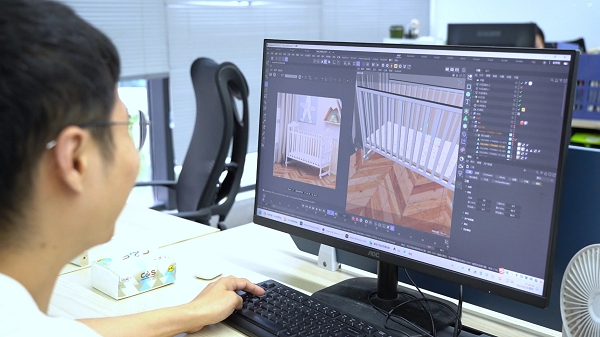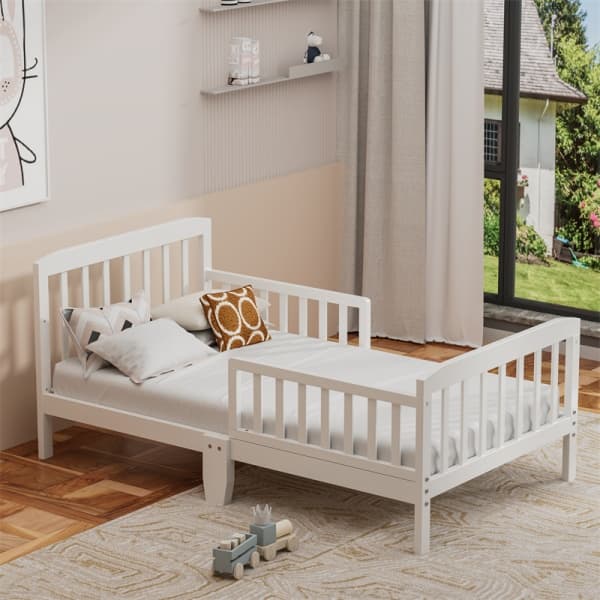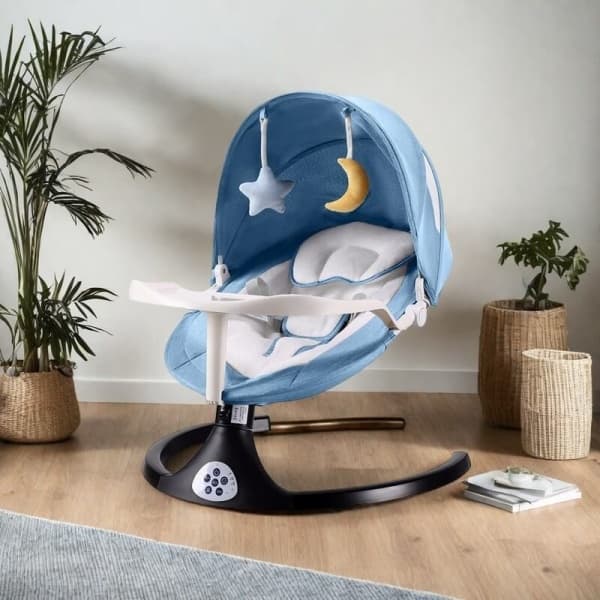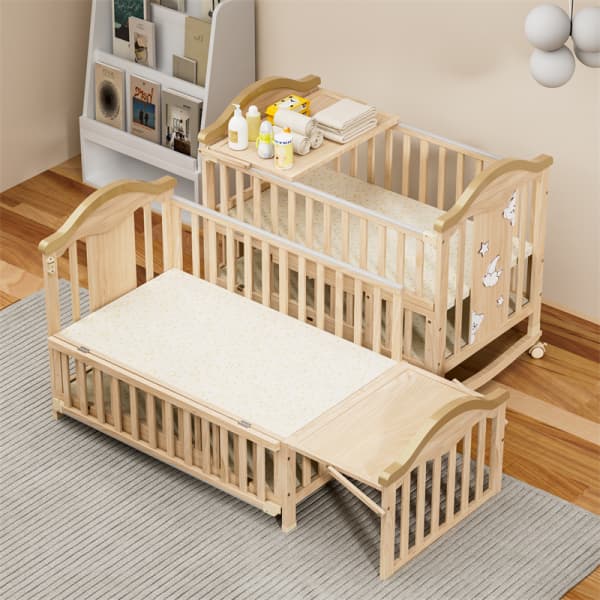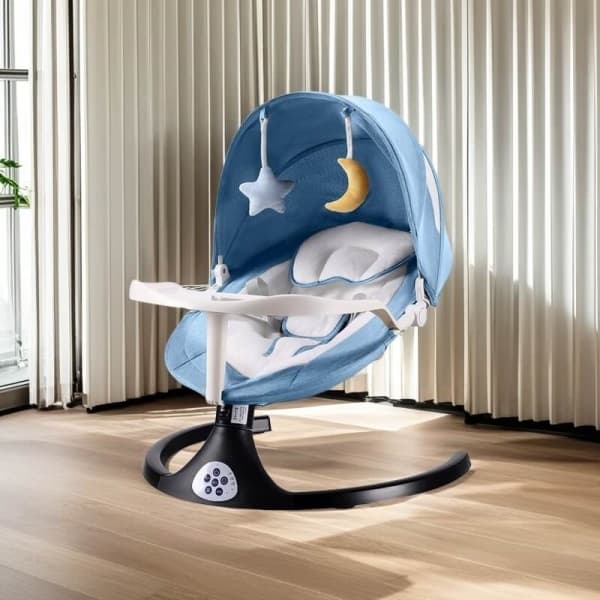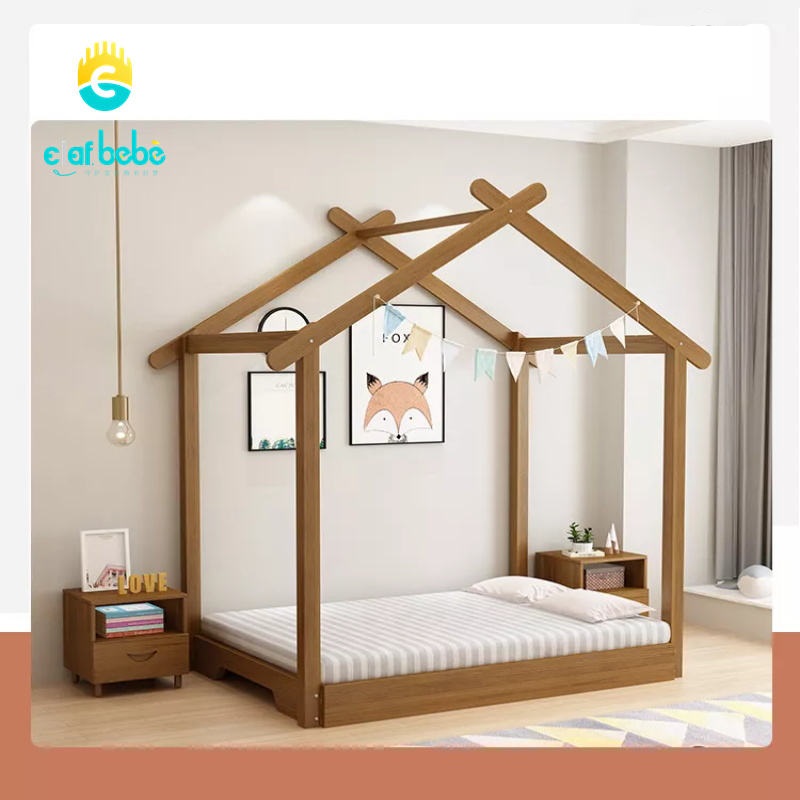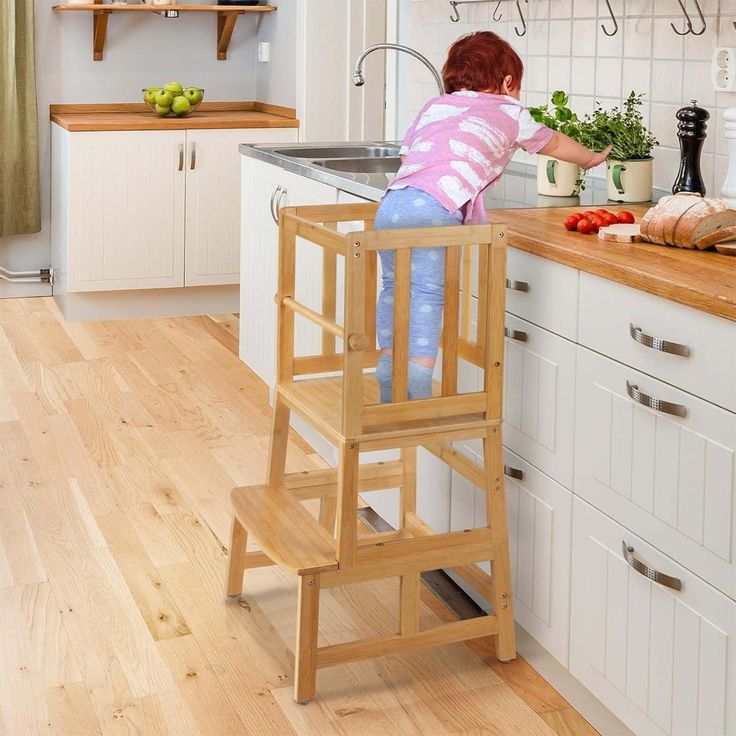If your little one has outgrown the crib and you’re navigating their next sleep transition, you’ve likely eyed the toddler bed—that just-right middle ground between the snug safety of a crib and the adventurous freedom of a “grown-up” bed.
So, what size is a toddler bed?
In this guide, we’ll explore the essentials of toddler bed sizing. You’ll learn how to decode dimensions, spot safety red flags, and time the transition so it feels natural, not rushed.
How Big Is a Toddler Bed?
Standard Toddler Bed Dimensions
In the United States, most toddler beds follow a 28-inch width by 52-inch length (71 cm x 132 cm) standard.
These beds stand just 12–18 inches tall (mid-shin height for most adults), a safety-first design that lets tiny climbers enter and exit safely while minimizing fall risks. Manufacturers typically recommend retiring the bed once a child hits 50 pounds or 40 inches tall – whichever comes first (usually around age 3-4).
The snug fit between mattress and frame acts like a baby gate for wandering limbs, preventing dangerous gaps. The compact size mimics a crib’s cozy embrace, offering toddlers psychological comfort during this “big kid” transition.
For scale, picture a twin bed shrunk by one-third – roomy enough for midnight acrobatics but compact enough to tuck into tight spaces like studio apartments or shared sibling rooms.
Variations in Toddler Bed Sizes by Region
While the U.S. standard reigns domestically, global sizing quirks matter for international families or imported furniture:
United Kingdom: Often match U.S. width (70 cm/27.5”) but stretch to 140 cm/55” long – like adding a footrest for growing legs.
European Union: Standard 70 cm x 140 cm (27.5” x 55”), with Scandinavian models sometimes reaching 160 cm/63” (think “toddler-to-teen” longevity).
These differences create real-world headaches: A U.S. crib mattress (28”x52”) in an EU bed leaves 3-inch gaps at the foot – enough space for tiny toes to catch. UK/EU “cot bed” sheets (labeled 70x140cm) drown smaller U.S. mattresses, creating pooling fabric hazards.
U.S.-made sheets stretched over longer EU frames may tear at seams during bedtime rebellions.
Always triple-check:
✔️ Local measurement standards (imperial vs. metric)
✔️ Mattress/frame compatibility notes in product manuals
✔️ International return policies (in case of misfit disasters)
What Age Are Toddler Beds Suitable For?
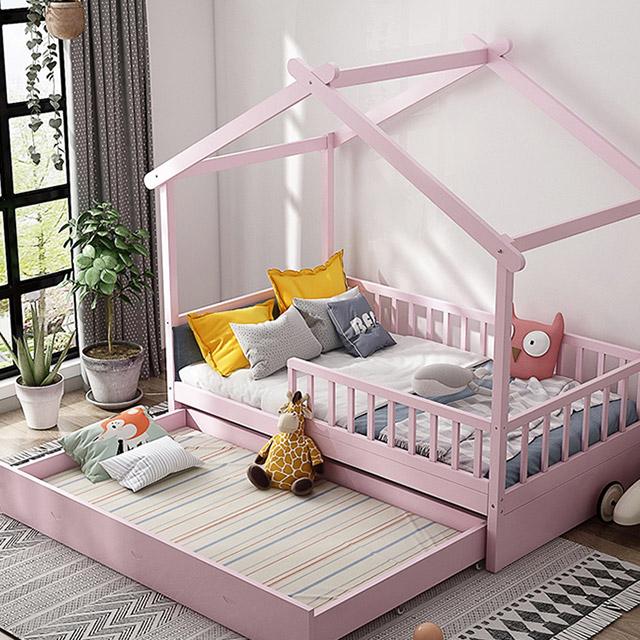
Toddler beds serve children during a sweet spot phase—longer than a growth spurt but shorter than you’d expect. While age offers a rough roadmap, your child’s physical growth and budding independence ultimately dictate the timeline.
Most families make the switch between 18 months and 3 years. This window aligns with key milestones, such as outgrowing the crib’s weight or height limits, mastering climbing skills, or showing interest in a “big kid” bed.
However, age alone isn’t a definitive marker. Some toddlers may need to move earlier due to safety concerns (like crib climbing), while others thrive in a crib until closer to age 3.
Toddler beds aren’t forever furniture. Most hit their retirement age when your child:
✓ Nears 50 lbs
✓ Stands 40” tall
✓ Starts resembling a folding pretzel in the bed
This usually happens around 4-5 years old—right when they’ll campaign for bunk beds or race car-themed upgrades.
Is a Toddler Bed the Same Size as a Crib
The short answer is yes—and no. While toddler beds and cribs share identical mattress dimensions, their designs cater to vastly different needs as your child grows. Let’s unpack the nuances.
Both toddler beds and standard cribs use the same mattress size, 28 inches wide by 52 inches long (71 cm x 132 cm). This intentional consistency allows parents to reuse their existing crib mattress, saving money and maintaining familiarity for the child.
Design Differences
Where toddler beds and cribs diverge is in their structure:
Height: Cribs are designed with high rails (often 30+ inches tall) to safely contain infants. Toddler beds, however, sit much lower—typically 12–18 inches off the ground—to allow easy access for toddlers learning to climb in and out independently.
Guardrails: Cribs feature full-length rails on all sides, while toddler beds usually have partial guardrails (5–9 inches high) on one or both sides. These shorter rails prevent falls without stifling a child’s newfound mobility.
Aesthetic: Toddler beds often incorporate playful themes (e.g., race cars, princess castles) to appeal to a child’s imagination, whereas cribs prioritize minimalism for versatility.
Toddler Bed Vs Kids’ Bed Sizes
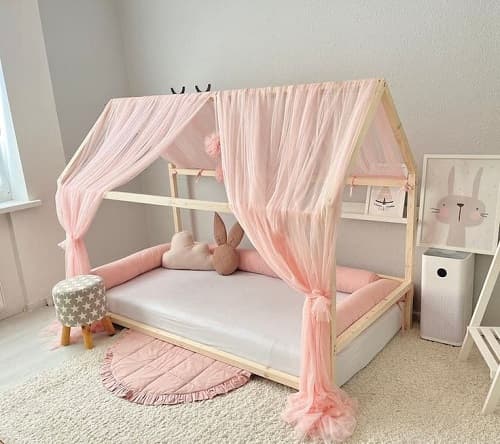
A “kids’ bed” typically refers to larger beds designed for children aged 5–6 and older, such as twin beds (38” x 75”) or full beds (54” x 75”).
Unlike toddler beds, which act as transitional sleep spaces, kids’ beds are built to accommodate older children through adolescence. They lack built-in safety features like guardrails but offer more room to stretch, play, or share with siblings.
The following are the specific differences between the two.
Size and Dimensions
| Feature | Toddler Bed | Kids’ Bed (Twin/Full) |
| Dimensions | 28” W x 52” L (71 cm x 132 cm) | Twin: 38” x 75” (96 cm x 190 cm) Full: 54” x 75” (137 cm x 190 cm) |
| Height | 12–18” off the floor | 18–24” off the floor |
| Weight Limit | Up to 50 lbs (23 kg) | Twin: 250+ lbs (113+ kg) Full: 400+ lbs (181+ kg) |
| Typical Age Range | 18 months – 4 years | 5 years – Adolescence |
Toddler beds are one-third the width of a twin bed and significantly shorter in length. Their compact size prioritizes safety and accessibility, while kids’ beds focus on long-term comfort and space.
Safety and Design
Toddler Beds include partial guardrails (5–9” tall) to prevent falls and sit low to the ground to minimize injury risks. They use thinner mattresses (4–6” thick) to maintain a low profile.
Kids’ Beds, on the other hand, lack built-in guardrails and require thicker mattresses (8–12”). Their higher frames may necessitate step stools for younger children, and while they lack toddler-specific safety features, parents can add removable bed rails for transitional phases.
Purpose and Longevity
Toddler beds act as a stepping stone between cribs and larger beds. They’re ideal for children who need the security of a confined space but are ready to climb in and out independently. Most families use them for 2–3 years before transitioning to a twin or full bed.
Kids’ beds, howe
ver, are long-term investments. A twin bed can last through the teen years, while a full bed accommodates sleepovers or shared rooms.
Space and Cost Considerations
Toddler beds excel in small rooms or shared spaces, fitting snugly into nurseries without overwhelming the layout. They’re cost-effective if you reuse a crib mattress, though their shorter lifespan means eventual replacement.
Kids’ beds demand more planning. A twin bed occupies 40% more floor space than a toddler bed, and a full bed nearly doubles it. They also require larger bedding and mattresses, increasing initial costs.
Safety Considerations Related to Toddler Bed Size
Mattress Fit
A toddler bed’s mattress must fit snugly within the frame, leaving no gaps wider than 1.5 inches (3.8 cm) between the mattress and bed edges. Even small gaps can trap limbs or pose suffocation hazards if a child rolls against the side.
This standard, upheld by organizations like the U.S. Consumer Product Safety Commission (CPSC), ensures that crib mattresses (designed for the same dimensions) transition seamlessly to toddler beds.
Measure your existing crib mattress before purchasing a toddler bed. Press the mattress firmly into the frame and check for gaps with your hand. If two fingers can slide between the mattress and frame, it’s too loose.
Guardrail Height and Spacing
Ideal guardrails are 5–9 inches tall—high enough to prevent rolling out but low enough for easy entry and exit. Gaps between guardrail slats should never exceed 2.5 inches (6.3 cm). Wider spacing risks trapping arms, legs, or even a child’s head.
Weight and Height Limits
Every toddler bed has a maximum weight limit (typically 50 lbs/23 kg) and height limit (around 40 inches/102 cm). Exceeding these limits can weaken the bed’s structure, increasing the risk of collapse. Always check the manufacturer’s guidelines, and transition to a larger bed once your child approaches these thresholds.
When to Transition to a Bigger Bed (Twin or Full?)
Most toddler beds accommodate children up to 50 pounds (23 kg) or 40 inches (102 cm) tall. If your child’s feet dangle over the edge, they frequently wake up cramped, or they’ve hit the bed’s weight limit, it’s time to upgrade. It is typically between ages 4 and 5.
Twin beds (38” x 75”) are the most popular choice for young children. Their narrower width provides ample room to grow without overwhelming small bedrooms.
Full beds (54” x 75”) suit families prioritizing long-term use or shared sleeping arrangements. While they offer more space for sleepovers or co-sleeping, their larger footprint demands careful room planning. Full beds are often better suited for older children or teens.
Conclusion
From the snug dimensions of a standard toddler bed to the intentional design of guardrails and low-to-the-ground frames, every detail plays a role in creating a secure sleep environment. By prioritizing a snug mattress fit, adhering to weight limits, and respecting your child’s developmental cues, you transform a simple piece of furniture into a trusted space.
As your toddler grows, so too will their needs. Transitioning to a twin or full bed marks another milestone, but the principles remain the same: measure carefully, prioritize safety, and involve your child in the process.

